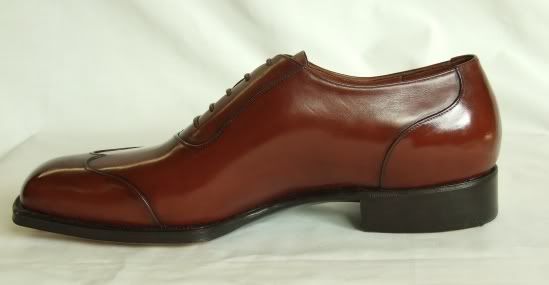cdmoore1855
Senior Member
- Joined
- Dec 27, 2008
- Messages
- 510
- Reaction score
- 9
I have just found some pics of some shoes you made, considering I understand your forte is boots, these look very nice. The sole work looks very nice




STYLE. COMMUNITY. GREAT CLOTHING.
Bored of counting likes on social networks? At Styleforum, you’ll find rousing discussions that go beyond strings of emojis.
Click Here to join Styleforum's thousands of style enthusiasts today!
Styleforum is supported in part by commission earning affiliate links sitewide. Please support us by using them. You may learn more here.


I have just found some pics of some shoes you made, considering I understand your forte is boots, these look very nice. The sole work looks very nice
This is really impressive. It also reminds me why I first came to SF, it's for articles like this. I have a question though: Some shoemakers use a metal shank inside the sole obviously to add more support to the shoe. But some other shoemakers (in the same league I may add) don't do this. Is there any real advantage or disadvantage for such use of the metal shank? Also, does it depend on welting techniques?
DWFII, something that is always on my mind is leather upper quality. What makes a long last durable upper, is it the hide itself, the tanning process, or the care that ultimately makes for a crackless upper? You hear this term breathability all the time, but does leather actually breathe? Is anything you do to an upper mostly cosmetic in the end? Thanks very much for all of your posts.

Eloquently stated as usual. Thank you. I hear that most leather linings are vegetable tanned and uppers are chrome tanned. Does vegetable tanned leathers have more moisture wicking properties as to not absorb as much foot sweat? Also, I have noticed in videos of shoemaking factories leather uppers seem very pliable and flexible, however when you actually purchase a shoe the leather is very stiff. Is this due to just the lasting process, or is it because of the vegetable tanned linings providing most of that stiffness?
DW, My english is not well, it is also very diffcult for me to talk about shoe construction in english too. But I think you get most of the ideas of what I was talking. Would you kindly comment on the method of welting on this link?
DWFII, how do you look at vegetable tanned uppers versus chrome tanned uppers? I spoke to a very experienced belt maker who said that there is only one reason to use chrome tanned leathers when working with leather goods: profit margin. Do you agree?
 Nicks Boots - Wickett & Craig English Bridle Veg Tan Leather - $759
These boots are made from 6.5 oz Wickett & Craig English Bridle Leather. This tannery has been making leather the old fashioned way since 1867. Each side can take about six weeks to produce, making it a significantly longer production time than most leather on the market.
Nicks Boots - Wickett & Craig English Bridle Veg Tan Leather - $759
These boots are made from 6.5 oz Wickett & Craig English Bridle Leather. This tannery has been making leather the old fashioned way since 1867. Each side can take about six weeks to produce, making it a significantly longer production time than most leather on the market.